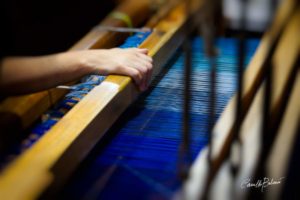TRAME DI STORIA
- No products in the cart.
Subtotal
€0.00
The difficulties of the weaver: a brief overview of how an artisan lives the relationship with non-artisans.
When I am asked what work I do and I reply that I have a hand weaving workshop, I often hear the answer:
“Wow, wooonderful!!!
Except then to read in the eyes of my interlocutor a certain blank expression, which makes me understand that he has no idea what I am talking about …
then I have to explain myself better so that it is clear that he is not ignorant, but mine is not really a “normal” job and it is one of the oldest professions in the world (together with the other, the famous one, even if I am not so sure that for me it is edifying to approach them XD); at that point it often becomes clear what I do and almost always people ask me questions about it, which I gladly answer, or we move on to other talks because, what I do for a living, that person cannot care less and if if I were an electrician I would probably be more interesting …
but the real challenge to overcome the difficulties of the weaver and more generally of every artisan is to make the vast majority of Italians understand that, if the price of that item is higher than one with a similar use (which you would find in any shop) , it is because it is a practically unique piece, it has a design time, long construction times, high quality materials and presumably various failures at the base of that successful project;
if there was any well-known brand written in large letters, Italian probably wouldn’t object and I know what I’m talking about because, having worked in the field, I assure you that if there is a brand above many people with average earnings are willing to spend even € 60 for a viscose scarf;
I don’t want to launch an invective against brands and those who buy them (in fact, I like them too), but it discourages me a lot when you don’t appreciate the difference … it just happened a few days ago that a passer-by, looking absently at an article I had exhibited outside, he said aloud (as if I had no ears and the door was closed): – What ?! all this money for a piece of canvas, are we kidding?! -.
Here, in my head the image formed of me giving him a head in the forehead, charging like a ram, but in reality I only pointed out that it was a handmade article and he had made a good fool;
the gentleman in question even apologized, even if I’m not convinced he knew why …
Well, hearing these words from someone who has no idea of your job is like a stab; implicitly equating your work to the chinoiserie that reigns everywhere (with respect for chinoiserie) and mortifies the effort made to produce your “work”.

Being artisans means cursing the world because the tool of your trade does not listen to you and breaks, or you are simply tired and you do a bullshit that makes you waste a lot of time;
But being an artisan is also the satisfaction of seeing a finished and successful project, an article that you know you have “given birth”; it is the satisfaction of putting a very small part of you in your creations and knowing that it will go around the world with them;
it is rejoicing when someone who appreciates your work showeres you with compliments and maybe even buys something telling you that he will remember you every time he wears it;
And being weavers is a vocation, more than a job;
we are carrying out an art that is disappearing made of gestures that have been repeated the same for centuries and there is a certain reverence in doing so.
Being weavers today is an uphill road, I already knew it before embarking on this adventure, but it is a climb that I am willing to take and I know that I will not stop until I reach the summit.